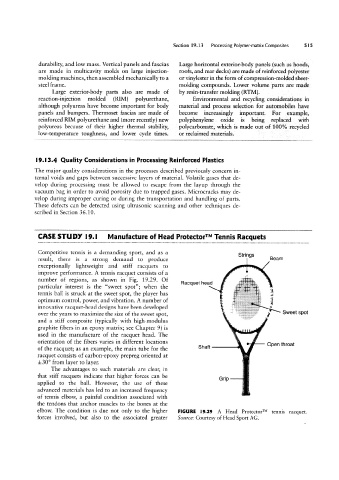Page 535 - 04. Subyek Engineering Materials - Manufacturing, Engineering and Technology SI 6th Edition - Serope Kalpakjian, Stephen Schmid (2009)
P. 535
Section 19.13 Processing Polymer-matrix Composites 5l5
durability, and low mass. Vertical panels and fascias Large horizontal exterior-body panels (such as hoods,
are made in multicavity molds on large injection- roofs, and rear decks) are made of reinforced polyester
molding machines, then assembled mechanically to a or vinylester in the form of compression~molded sheet-
steel frame. molding compounds. Lower volume parts are made
Large exterior-body parts also are made of by resin-transfer molding (RTM).
reaction-injection molded (RIM) polyurethane, Environmental and recycling considerations in
although polyureas have become important for body material and process selection for automobiles have
panels and bumpers. Thermoset fascias are made of become increasingly important. For example,
reinforced RIM polyurethane and (more recently) new polyphenylene oxide is being replaced with
polyureas because of their higher thermal stability, polycarbonate, which is made out of 100% recycled
low-temperature toughness, and lower cycle times. or reclaimed materials.
l9.I3.4 Quality Considerations in Processing Reinforced Plastics
The major quality considerations in the processes described previously concern in-
ternal voids and gaps between successive layers of material. Volatile gases that de-
velop during processing must be allowed to escape from the layup through the
vacuum bag in order to avoid porosity due to trapped gases. Microcracks may de-
velop during improper curing or during the transportation and handling of parts.
These defects can be detected using ultrasonic scanning and other techniques de-
scribed in Section 36.10.
CASE STUDY l9.l Manufacture of Head Protectorm Tennis Racquets
Competitive tennis is a demanding sport, and as a
Strings Beam
result, there is a strong demand to produce
exceptionally lightweight and stiff racquets to
improve performance. A tennis racquet consists of a
number of regions, as shown in Fig. 19.29. Of
Racquet head S H mi 21.
particular interest is the “sweet spot”; when the
tennis ball is struck at the sweet spot, the player has 5 il
optimum control, power, and vibration. A number of
innovative racquet-head designs have been developed
over the years to maximize the size of the sweet spot, I Sweet spot
and a stiff composite (typically with high-modulus
graphite fibers in an epoxy matrix; see Chapter 9) is
used in the manufacture of the racquet head. The
orientation of the fibers varies in different locations
Shaft A if Open throat
of the racquet; as an example, the main tube for the
racquet consists of carbon-epoxy prepreg oriented at
130° from layer to layer.
The advantages to such materials are clear, in
that stiff racquets indicate that higher forces can be
G rip
applied to the ball. However, the use of these
advanced materials has led to an increased frequency
of tennis elbow, a painful condition associated with
the tendons that anchor muscles to the bones at the
elbow. The condition is due not only to the higher FIGURE l9.29 A Head Protectorm tennis racquet.
forces involved, but also to the associated greater Source: Courtesy of Head Sport AG.

